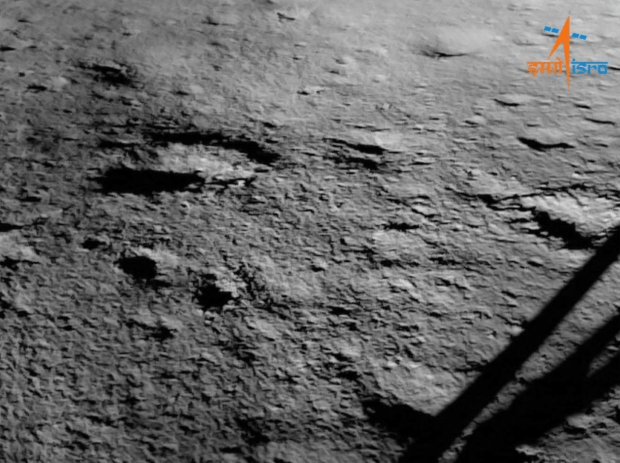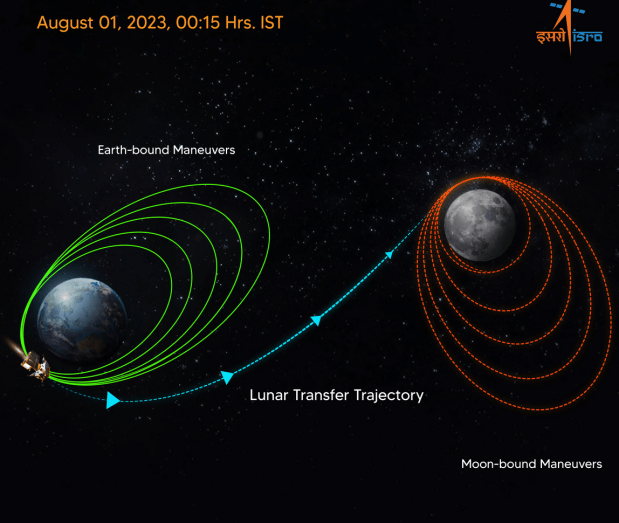On Aug. 23, 2023, the Indian Space Research Organization’s (ISRO) Chandrayaan-3 mission landed near the Moon’s south pole, and a day later, the rover took a walk on the lunar surface. India is the first country to land on the Moon since 2020, when China’s Chang’e 5 visited our satellite to collect lunar surface samples.

“The country has now joined a select club of nations that have achieved this technically difficult feat,” says Richard de Grijs, professor for the School of Mathematical and Physical Sciences for Macquarie University in Sydney, in an email. India joins the U.S., Russia, and China as lunar visitors.
Chandrayaan-3 officially launched into orbit on July 14 from the island Sriharikota off the coast of India. To achieve the proper landing, the mission performed multiple orbit-raising maneuvers before entering translunar orbit. On Aug. 23, the mission announced on the ISRO website, “I reached my destination and you too!” The Vikram lander, which contained the Pragyan rover, made a soft landing on the surface and the rover rolled out of the lander the day after. They are expected to conduct experiments for the next 14 days, or one lunar day, but they are not expected to return to Earth.
This is the first successful landing for the country. Four years ago, Chandrayaan-2 entered into lunar orbit, but the lander and rover crashed into the Moon’s surface. (The orbiter, however, remains operational to this day.)
The current goals of this mission are to demonstrate the capability of the lander and rover on the lunar surface, as well as conduct scientific experiments, according to ISRO. The modules will test the Moon’s surface plasma density, thermal properties, soil composition, and internal activities. The surface of the Moon’s south pole is believed to house water ice across its more rugged terrain than previously explored areas of the Moon. “That might give us new insights into the formation of the lunar surface and the internal processes that operated much earlier during the Moon’s lifetime,” says de Grijs.

The journey Chandrayaan-3 took after launching July 14, 2023. Credit: ISRO
Failed mission
Recently, a similar venture by Roscosmos, Luna-25, launched on Aug. 10 with the same goal as Chandrayaan-3: to land on the lunar south pole. However, on Aug. 19 an “abnormal situation occurred,” according to a translated news release on the agency’s social media. The craft then lost contact with ground control and crashed on the lunar surface.
According to the organization, there was a technical glitch; Roscosmos is investigating the incident. The last time Russia (at the time the Soviet Union) visited the Moon was in 1976, with Luna-24.
Despite the recent loss of the rocket, Russia continues to plan for future Moon missions such as the Luna-26 (Luna-Resurs Orbiter) for 2027 and Luna-27 (Luna-Resurs Lander) for 2028. It has yet to be determined whether these will be pushed back in order to reassess the technology used.
Sights on the future
Roscosmos and ISRO’s missions are just the start of what could be a new space race.
“We will no doubt see more such efforts from a range of established and emerging space-faring nations, not least from Japan in the near future, and with a particular focus on landing near the Moon’s south pole,” says de Grijs. Japanese Aerospace Exploration Agency’s (JAXA) and NASA are expected to launch the Smart Lander for Investigating Moon (SLIM) with the X-Ray Imaging and Spectroscopy Mission (XRISM) over the weekend. JAXA is also working in collaboration to launch the Chandrayaan-4 mission as early as 2026.
As nations continue to set their sights on visiting the Moon, NASA’s plans also continue to move forward. It was announced in March that the Artemis II mission would take place in November 2024. This marks the first time astronauts will head to the Moon in over 50 years.
Over a 10-day period, four astronauts will take a trip into translunar orbit before returning to Earth. The purpose of the mission is to test Space Launch System rocket on the Orion spacecraft and the communications with ground control.
These tests will allow astronauts aboard Artemis III, scheduled for 2025, to explore the Moon’s South Pole. This would be the first time anyone has set foot on the lunar surface since 1972.
Source: Astronomy
